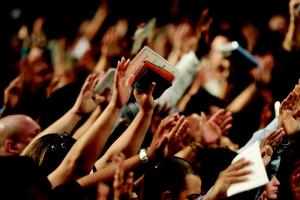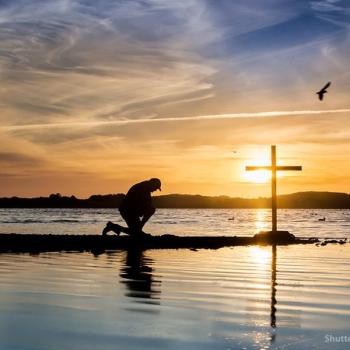
SALT LAKE CITY — With religious services taking place online, this might seem like a moment for digital natives like Gen Z to step into the stream of faith. But new data suggests that the opposite is happening.
Pew Research Center reports that those under 30 are the least likely to tune in to virtual worship. Similarly, new data show prior to the pandemic, 13- to 17-year-olds attended in-person religious services at rates similar to their parents — but they were much less likely to pray.
Researchers, however, argue that surveys of religious belief often ask the wrong questions to gauge the faith of youth and young adults. They say that Gen Z — a group that was born from 1997 and later — is eager for spiritual engagement but the form it takes might confound conventional ideas of worship.
Young people aren’t “becoming more or less religious,” says Elizabeth Drescher, a professor of religion at Santa Clara University and the author of “Choosing Our Religion: The Spiritual Lives of America’s Nones.” “They’re becoming differently religious.”
Some also say that Gen Z’s lack of affiliation and low rates of online engagement can be understood not as a crisis but as an opportunity for religious leaders to rethink the way they’re doing church — not just for youth but for everyone.
Showing up but not praying
A newly released study by Pew Research Center found that, prior to the pandemic, America’s teenagers attended religious services at rates that were nearly identical to their parents with 44% of teens saying that they go to services at least once a month and 43% of their parents reporting the same.
While church attendance is similar among adults and their teenage children, their feelings about organized religion differ. Some 43% of parents said religion is “very important” in their lives, only 24% of teenagers said so. When they were asked about daily prayer, 27% of teenagers reported doing so in comparison to 48% of parents.
So while teenagers might be going along with their parents to church, their low rates of prayer — and the relatively few who rank religion as “very important” — suggest they might not be accepting formal worship.
Because of that, researchers cautioned against drawing conclusions that Gen Z will reverse the national march toward secularization. They also pointed out that a drop in religious observance is typical when children leave the nest and so the age group surveyed — 13 to 17 — may change their practices when they leave home.
Generation Z’s low engagement with virtual religious services dovetails with this data. Pew Research Associate Claire Gecewicz says that when polling about religious practices was conducted in July, “older adults were more likely than their younger counterparts to say they had watched religious services online or on TV in the last month.”
Of those 65 and up, Gecewicz says, 43% reported watching online services in the last month. For the 50 to 64 crowd, 38% had viewed virtual services, while fewer than a third of adults 30 to 49 had attended online services and less than a quarter of those under 30 tuned in.
Spirituality and protesting
But those who work closely with teens and young adults say Gen Zers are just as spiritually inclined as older generations. The latest research from Pew points in that direction with 8 out of 10 teenagers reporting that they believe “in God or a universal spirit” and 77% saying that they feel a “strong sense of gratitude” more than once a month.
When considering Gen Z’s religiosity, people have to change their understanding of what constitutes a spiritual practice, says Drescher, including avenues of expression that are often missed by the “affiliation based measures” common to polls.
“Most of the surveys,” Drescher explains, “ask things like ‘Do you believe in God or a higher power?’ or ‘Do you attend worship services?’”
Though a majority of her students “identify as non-religious,” Drescher says, they “still look for social structures to express community cohesion and shared values and stories that create shared meaning.”
Many of Drescher’s students have found that “in a spiritually rich Black Lives Matter movement” and other social justice causes.
Those who attended Black Lives Matter protests and marches this summer, she says, reported experiencing that “social justice work” as “being part of something that is transcending, that is bigger than oneself,” Drescher says. They also felt like they were gathering with others who held “common commitments and perspectives,” and that doing so constituted “a meaningful way to make change”— which all sounds a lot like a religious experience.
“We’re seeing the same kind of things,” Drescher observes. “The physical body, the social body … is engaged in the world in a way that hasn’t been happening as much in brick and mortar churches in recent years.”
Drescher says that youth participation in the Black Lives Matter movement comes from a well of “moral and ethical hunger.”
Social media, she argues, also feeds and amplifies that hunger. It starts with social media making visual “the moral abuses of the culture,” something young people experience as “an incarnational pull,” Drescher says. “People are drawn to be with other people by what they are seeing and learning and feeling on social media.”
But if BLM fizzles out, where will Gen Z take that hunger for community and shared values and spiritual sustenance?
Drescher doesn’t think that the quest for social, racial and economic justice will end anytime soon. The “moral abuses” of our culture — made visible on social media — will continue to pull young people into the streets, she says.
Shifting to community
The manner in which youth engage — or don’t — in this virtual moment points to larger issues that churches should be wrestling with right now, according to Dr. Heidi Campbell, a professor of media and religion at Texas A&M University and the author of “Digital Religion: Understanding Religious Practice in New Media Worlds.”
As religious institutions rushed to get online when the pandemic began, many religious leaders assumed “if we do a broadcast version of our service all will be well,” Campbell says.
People felt “disconnected” as a result, Campbell says. “Just because you use social media doesn’t mean you increase social interaction in the space.”
Religious leaders have “to build a community integrating the technology,” she continues. “Just having events online or offline doesn’t mean you have a community.”
And that seems to be what’s missing in bringing Gen Z into the fold — community, participation, connectedness.
Some religious leaders have “created a religion that has been very event-based and experience-based and not very community-based,” Campbell observes.
This moment, however, presents an opportunity to rethink everything. Religious institutions, Campbell says, should be “trying new ways of gathering and trying new ways of meeting … (including) small groups to talk about services online or on the phone.” In that model, the focus isn’t on a pastor or an event. Rather, the sermon “becomes a conversation point” for a community to build upon.
Spectator or participant
Similarly, Pastor Zach Lambert, of Restore Austin, a nondenominational church, reports that since the pandemic began youth engagement was highest when a Black staff member hosted a Zoom discussion about racial bias.
“We had a ton of young folks on that call,” Lambert says. “That was really their main church participation since COVID hit.”
Lambert — who is a millennial himself and was just 26 in 2016 when he, his wife and another couple they met in seminary founded Restore Austin — adds that he believes participation is the key to attracting Gen Z to any sort of spiritual activities.
“We’ve seen a hunger in Gen Z for more experiential stuff — something they get to participate in rather than receive. They want to belong to a community rather than an audience,” Lambert remarks.
“Online is complete audience,” he says. “You can’t even create a facade that it’s participatory. I think that’s why you’re seeing a drop in participation during COVID.”
But, since the pandemic began, whenever Restore Austin holds an online event that is both justice-oriented and participatory, Lambert adds, “even if they’re online, we see the (number of) young people participating go way up.”
Restore Austin offers a different approach to faith in large part because that’s what Lambert and the clergy always aimed to do so. He explains that they started their church to reach out to “people who have been disenfranchised by church or disillusioned by religion — people who have what we call ‘church hurt.’”
“We’re the church for people who don’t like church very much,” Lambert quips.
Restore Austin is unconventional in other ways — for one, it doesn’t have a building. Prior to the pandemic, it set up every Sunday in a middle school in downtown Austin. After main services, congregants got into smaller breakout groups.
Not having a brick-and-mortar church helps Lambert keep the congregants’ focus not on a place but, rather, on the “primary beliefs that Christians have had for thousands of years.” Lambert also follows a policy of “full inclusion,” positioning what he calls “secondary issues” firmly to the side.
Lambert reports that Restore Austin has seen “slow but steady growth” over the past four years. One of the things that he is most proud of is that 80 percent of his members are people who had abandoned church and had disconnected from organized religion before they found Restore Austin. Most of those people are millennials, Lambert adds, and about a quarter are Gen Z.
Though Lambert’s observes that young people aren’t attending online services in large numbers — as Pew’s findings suggest — his experience points to Campbell’s remark that community and small groups are the key to participation. “We’ve got pretty vibrant small groups on Zoom right now,” he says. “The participation of young folks is way, way higher on that than it is on Sunday mornings.”
Written by Mya Jaradat, originally seen on https://www.deseret.com/













